Email list is one of the most successful digital marketing methods. You’ve added a new subscriber every time a customer chooses to receive promotional emails—someone you may contact directly. Therefore, we need to take advantage of this traffic opportunity to the fullest.
What Effect Does A Great Email List Have?
An email list provides a direct channel of connection with your target market, whether they are long-time supporters or brand-new prospects. Email marketing also plays a key role for online business owners since it is owned media, which means you don’t have to rely on other sources (like social networks) to reach your consumer base.
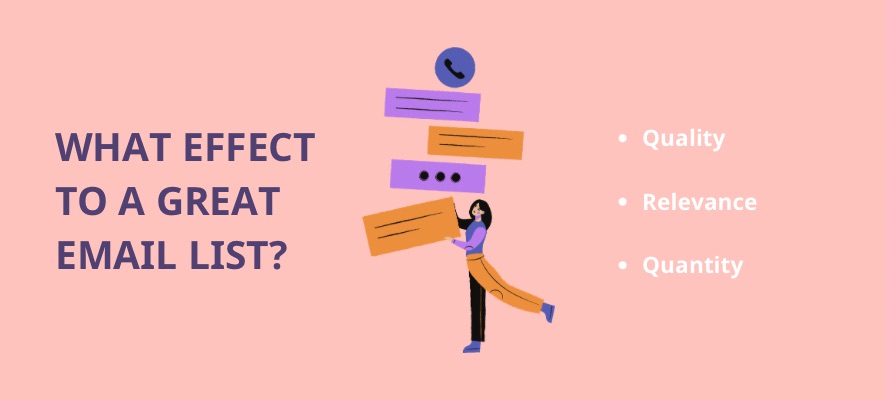
So, what makes a great email list that boosts sales at your online store:
Quality. Ask for detailed data from real people rather than purchasing email lists. Purchases are not made by bots, spam accounts, or abandoned email addresses.
Relevance. Converting customers who are already interested in your offering is difficult enough. Only include subscribers on your email list who are truly interested in your goods or services. A failure to do so will result in leads leaving as quickly as they came.
Quantity. Once you’ve completed the first two tasks, you can start focusing on building your email list and expanding your audience’s reach.
How To Build An Email List
Add a pop-up offer to your homepage
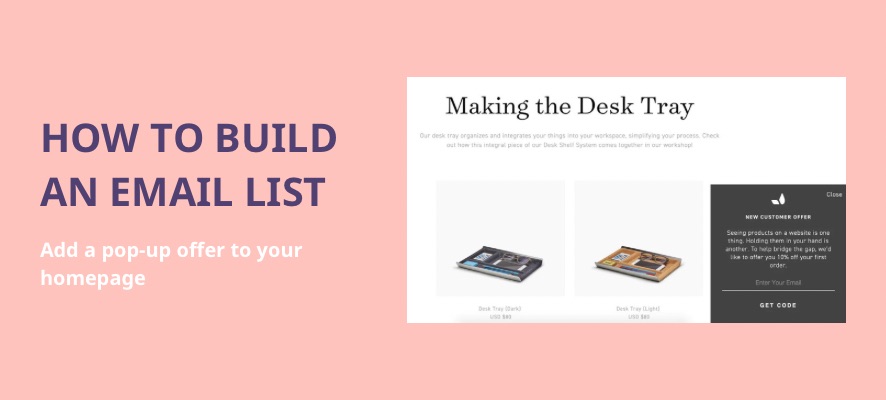
Promotional offers can be an effective tool for converting first-time website visitors before they press the back button, even if you shouldn’t encourage customers to wait for or expect discounts. You can grow your email list and avoid losing potential customers by using homepage pop-up forms.
If the term “pop-up” makes you uneasy, keep in mind that pop-up forms typically convert at a rate of around 3%, with the best ones converting at a rate of over 10%. These statistics could significantly boost your email signups, depending on the volume of traffic to your website.
Start with an exit intent pop-up to use pop-up forms to collect emails on your e-commerce website. These won’t appear unless a visitor moves their mouse off the page, which usually suggests they want to move on to another website.
For previous customers and site visitors who are already on your list, you may remove these pop-ups using the targeting factors in your favorite marketing platform. It allows you to customise your copy to attract potential customers.
You should think about offering a discount of some kind—as long as the math makes sense—because losing a customer before they make their first purchase can be challenging to recover. The total price of your product, your profit margins, and any future offers will all affect how profitable specific deals are for your business.
Put an opt-in form in your site’s navigation or footer
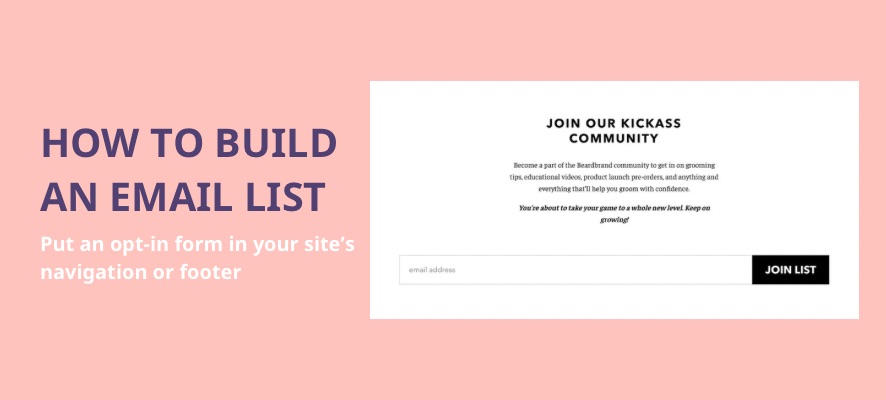
Giving visitors many chances is one way to get new subscribers for your email list. Because of this, you should think about including an email registration form on each page of your website in addition to a pop-up form on the homepage or product pages.
Most website systems let you insert opt-in forms in the margins, navigation bar, and footer—all places where customers are likely to go for more information about the business you run. Because these forms are often subtle and located below the fold, your conversion rate will likely be low overall. However, the impact they have over time on growing your list can be important.
Make sure you provide an attractive call to action about the benefits of joining up, such as a coupon, access to special topics, or frequent news and updates, to increase your conversion rate. What kinds of deals may encourage a customer to subscribe as they scroll down to your website’s footer to discover more about your business?
Collect email addresses at your store or in-person event
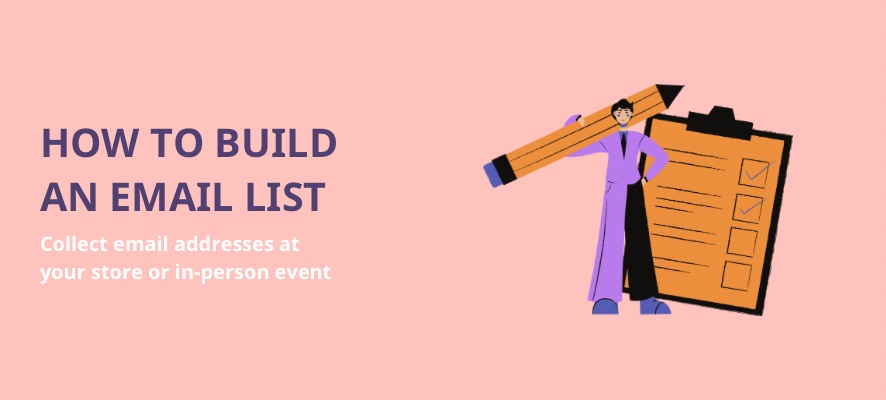
Even if a transaction doesn’t take place in person, personal relationships are still the most efficient way to convert leads into consumers. Your relationships can help you expand your email list, resulting in more online purchases, whether you run a brick-and-mortar store, are advertising your business at an event, or are operating a pop-up shop.
Keep in mind that forms frequently used for email marketing and lead generation can easily be converted from URL to IRL. To make it easier to work with your chosen email marketing solution, you could bring the clipboard and ask people to write down their names and email addresses, or you might offer an iPad where attendees may enter their information immediately. Even your business cards might have a CTA to encourage email signups.
Make sure you use a strong CTA to encourage in-person signups, just like you would with your online forms. For example, “Subscribe to our newsletter for 25% off your first online purchase” or “Sign up for our mailing list for a chance to win a $25 gift card.” To send emails that are appropriate for each audience’s needs, it is also a good idea to break up these lists based on place or occasion.
Build personalized landing pages
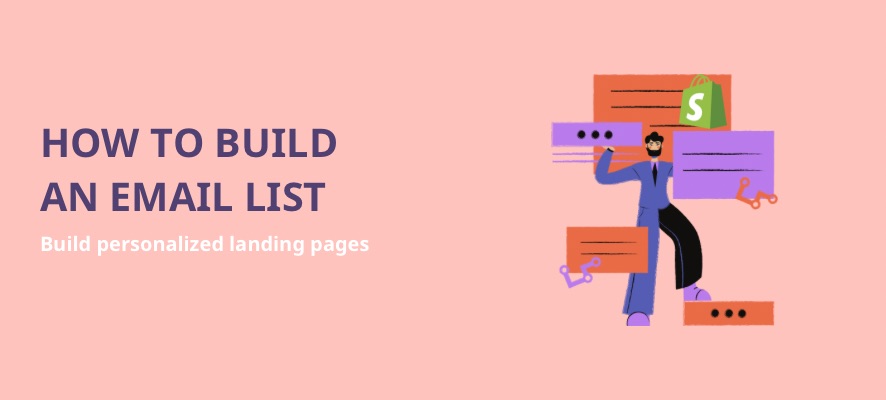
Use a strong CTA to encourage in-person signups, just like you would with your online forms. Like, “Subscribe to our newsletter for a chance to win a $25 gift card,” or “Subscribe to our newsletter for 25% off your first online purchase.” To send emails that are appropriate for each audience’s needs, it is a good idea for you to divide these lists by location or event.
Consider the sources of traffic to your e-commerce website before you begin to use personalized landing pages. Make sure your on-page language and CTA are clear and consistent with the offer that motivated visitors to your site in the first place, whether you’re creating a landing page for an evergreen audience or promoting an event or holiday.
Many apps with simple templates are available in Shopify’s App Store to help you create, test, and publish landing pages quickly to increase email signups. Individualized landing pages will be more effective in the long term than templates, according to research, which shows that personalized calls-to-action have a 42% higher form submission rate.
Include a newsletter signup option at checkout
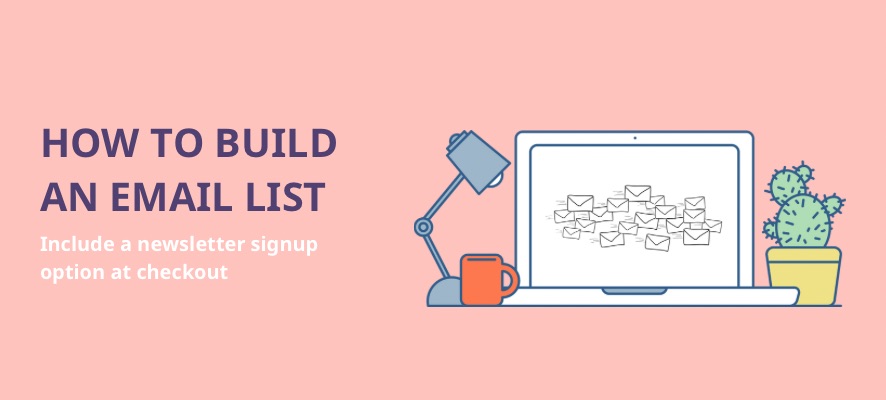
Since they already have a customer, it is clear that many online business owners fail to use their checkout page as a marketing tool. However, a single transaction does not mark the end of the buyer’s journey.
A lot of customers decide to finish their transaction without creating an account, limiting your future communications to those relating to their transaction. You may convert a one-time transaction into a loyal and repeat customer by inviting customers to subscribe to your email list at the point of purchase.
Just adding a checkbox beside the section where customers enter their email addresses for order confirmation can provide a checkout newsletter registration option. Be clear about the benefits customers will receive, such as email-only discounts, how-to articles, or product updates. This will not only explain their motivation for signing in, but it will also guarantee that you agree with the GDPR and other privacy laws.
In addition to a checkbox or text field, a popup or banner on your purchase confirmation screen may boost your checkout CTA. You’ll have a better chance of attracting a customer’s attention and getting an email list registration by making an interesting design.
6 Advanced Strategies To Boost Your Email List
It’s time to consider advanced methods to speed up the growth of your email list once you’ve laid an important foundation and begun collecting subscribers. Here are a few innovative ideas to help you advance the development of your email list.
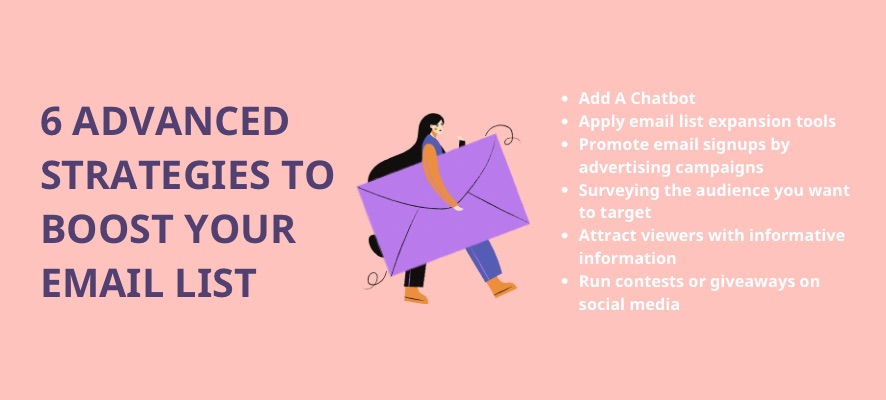
Add A Chatbot
Although chatbot technology is still in its earliest stages of development, it currently provides a lot of useful features to help you automate your conversation with website users. In addition to helping you produce unique offers and increase email list signups, this can help you save a lot of time and effort when it comes to customer service.
You can build personalized emails for customers using Shopify Inbox (available on all plans), and you can gather information while focusing on conversations that convert. Messaging is a very popular way for customers to connect with brands; it may be successful where a regular landing page or lead capture form fails.
Apply email list expansion tools
You may create your email list using several simple programmes, some of which provide tried and true strategies and creative new variations. Shopify Forms is a free tool that helps in creating leads and growing marketing lists.
Promote email signups by advertising campaigns
There are many choices for using internet ads to drive email list signups, whether you’re looking at social media, search, or another advertising channel. You may create an offer with a target audience in mind using the effective audience targeting tools in Google AdWords and Facebook Ads Manager, and then change factors like location, age, gender, job, interests, and more to target the ideal customers.
Surveying the audience you want to target
The key to creating a successful digital marketing plan is gathering the correct information. You can collect important data about the preferences, requirements, and feedback of your audience with visitor surveys and questionnaires while also collecting their email addresses for marketing purposes.
Start with a clear goal before using an online poll, such as market research or even crowdsourcing blog content. You can include a field in your survey to collect email addresses, and at the conclusion, you can ask participants whether they would like to join your email list. There are several simple tools and services available for creating consumer surveys if you have a purpose in mind.
Your survey should be sent to friends and family, posted in Facebook groups, mentioned on social media, and come with a discount for participants.
Attract viewers with informative information
It’s important to keep in mind that your physical product or subscription is not your only selling point when growing your email list. You began an online business to fill a need or solve a problem, so you have some excellent suggestions and options.
By sharing those concepts via blogging or downloadable content, you may create a lead magnet that benefits your target market and promotes brand loyalty, increasing email signups and, then, sales.
The ideal example is a free ebook or guide that contains more tips and tricks for your product category, case studies, or how-to information.
Run contests or giveaways on social media
By making the task of subscribing a shareable and winnable event, contests and prizes can speed up list growth. In the early stages, when your subscriber list is small and you don’t yet have any existing traffic to use, the extra energy of a contest can be especially useful.
Joining forces with other online stores that cater to comparable customers is one way to strengthen this strategy. Your items will match one another if you work with the correct partner, making the offer more attractive than if you performed the contest on your own.
Another choice is to search for influencers on social media platforms like Instagram, TikTok, and Youtube who are already connecting with your potential customers. You might be able to explain away the cost of offering your product in exchange for the ability to jump-start your giveaway campaign because influencers frequently use giveaways for their purposes, typically to cut through the competition and expand their following.
Some email marketing tools that can help you
Spending on platforms and solutions that will help you manage, organise, and use your data will be important as you expand your email list from a small number of members to a few thousand.
Some platforms that can be a marketing solution that helps you start: Shopify Email, MailChimp, Zapier, etc.
In Conclusion
Since no two businesses are exactly alike, it’s important to test different email list-building techniques to see which ones are most effective. Once you have a large number of relevant, focused customers, you may begin optimizing your email marketing to meet your specific goals.



